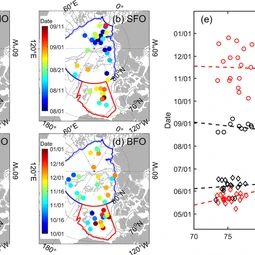The first complete picture of Arctic sea ice freeze-thaw cycle highlights sea ice response to climate change
5 December 2022
MUNICH – Years of research show that climate change signals are amplified in the Arctic, and that sea ice in this region is sensitive to increases in Arctic warming. Sea ice greatly modifies the exchanges of heat, momentum and mass between the atmosphere and the ocean. So, the timings of the sea ice melt and freeze onsets, as well as the length of the melt and freeze seasons, play a key role in the “heat budget” of the atmosphere-ice-ocean system.
Until now, most studies calculated the Arctic melt and freeze onsets using remote sensing observations from the surface, but rarely investigated the freeze-thaw process at ice bottom.
In a new study published today in the European Geosciences Union journal The Cryosphere, an international team of scientists synthesized multisource data from 2001 to 2018 to explore the spatiotemporal variations of both surface and basal melt/freeze onsets and uncover the mechanism behind them. These findings could improve our understanding of changes in the atmosphere–ice–ocean system and the mass balance of sea ice in a changing Arctic.
Possible delay in Arctic sea ice loss?
“Thinner ice thickness and thinner snow cover favors earlier basal freeze onset. The ocean plays a cross-seasonal role in regulating the growth or decay of sea ice,” explains lead author Long Lin from the Polar Research Institute of China.
The researchers found that the overall average basal freeze onset of Arctic multiyear ice was almost 3 months later than the surface. “Based on synchronous ice and underlying ocean observations, we found the ice basal freeze-up delay relative to the surface, which can be attributed to the regulation of heat capacity of sea ice itself and the oceanic heat release from the ocean mixed layer and subsurface layer,” Lin says.
According to Lin, although thinner ice generally experiences a longer freezing season, the total ice growth still cannot offset the sea ice loss in summer. “From another point of view, the self-regulation of the Arctic sea ice-ocean system will delay the loss of Arctic sea ice.”
New insights into surface and bottom ice melt onsets
The research also found that the most significant temporal difference of melt onsets between surface and bottom occurred in the Beaufort Gyre region, where basal melt onsets showed more than a half month earlier than surface. Besides, both multiyear ice and first-year ice in this region exhibit a trend towards earlier basal melt onset, which can be attributed to the earlier warming of the surface ocean caused by thinning of sea ice thickness and increasing of sea ice mobility.
These results present the first complete picture of Arctic sea ice freeze-thaw cycle, and its coupling with atmosphere atop and ocean underlying. It also highlights the importance of synchronous comprehensive monitoring of air-ice-ocean system, which helps explain the physical nature of the coupling process.
The researchers call for more intensive and elaborative ice mass balance observations of diverse ice types and simultaneous upper ocean water properties observations in the future. This, they hope, will vastly improve our ability to fully understand the Arctic ice-ocean system.
More information
The European Geosciences Union (EGU) is Europe’s premier geosciences union, dedicated to the pursuit of excellence in the Earth, planetary, and space sciences for the benefit of humanity, worldwide. It is a non-profit interdisciplinary learned association of scientists founded in 2002 with headquarters in Munich, Germany. The EGU publishes a number of diverse scientific journals that use an innovative open access format and organises topical meetings plus education and outreach activities. Its annual General Assembly is the largest and most prominent European geosciences event, attracting more than 14,000 scientists from all over the world. The meeting’s sessions cover a wide range of topics, including volcanology, planetary exploration, the Earth’s internal structure and atmosphere, climate, energy, and resources. The EGU 2023 General Assembly is taking place in Vienna, Austria, from 23 to 28 April 2023. For information please follow the EGU on Twitter and Facebook.
If you wish to receive our press releases via email, please use the Press Release Subscription Form at https://www.egu.eu/news/subscription/. Subscribed journalists and other members of the media receive EGU press releases under embargo (if applicable) 24 hours in advance of public dissemination.
Contact
Gillian D’Souza
Media and Communications Officer
European Geosciences Union
Munich, Germany
Email media@egu.eu

